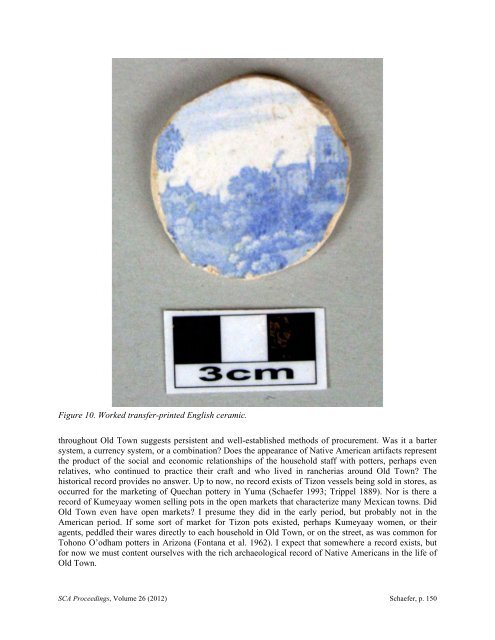Jerry Schaefer - Society for California Archaeology
Jerry Schaefer - Society for California Archaeology
Jerry Schaefer - Society for California Archaeology
You also want an ePaper? Increase the reach of your titles
YUMPU automatically turns print PDFs into web optimized ePapers that Google loves.
Figure 10. Worked transfer-printed English ceramic.<br />
throughout Old Town suggests persistent and well-established methods of procurement. Was it a barter<br />
system, a currency system, or a combination? Does the appearance of Native American artifacts represent<br />
the product of the social and economic relationships of the household staff with potters, perhaps even<br />
relatives, who continued to practice their craft and who lived in rancherias around Old Town? The<br />
historical record provides no answer. Up to now, no record exists of Tizon vessels being sold in stores, as<br />
occurred <strong>for</strong> the marketing of Quechan pottery in Yuma (<strong>Schaefer</strong> 1993; Trippel 1889). Nor is there a<br />
record of Kumeyaay women selling pots in the open markets that characterize many Mexican towns. Did<br />
Old Town even have open markets? I presume they did in the early period, but probably not in the<br />
American period. If some sort of market <strong>for</strong> Tizon pots existed, perhaps Kumeyaay women, or their<br />
agents, peddled their wares directly to each household in Old Town, or on the street, as was common <strong>for</strong><br />
Tohono O’odham potters in Arizona (Fontana et al. 1962). I expect that somewhere a record exists, but<br />
<strong>for</strong> now we must content ourselves with the rich archaeological record of Native Americans in the life of<br />
Old Town.<br />
SCA Proceedings, Volume 26 (2012) <strong>Schaefer</strong>, p. 150
















